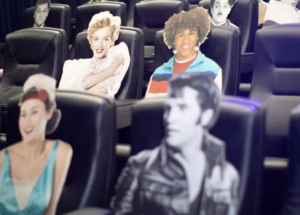by Melika Sadat Esmaeili
As the 7th Art, cinema not only maintained its status as a civilizing and vanguard media w modern technologies advanced but increased its influence over time and turned into a lucrative and civilizing industry and a powerful instrument in developed societies. The color was introduced to this great industry in 1903 when “The Great Train Robbery” was displayed in cinemas and led to more significant breakthroughs.
Nowadays, numerous elements transmit concepts; some are direct like dialogues, while others are indirect and are represented as hypotext like symbolic clothes and colors.
Colors represent diverse and even contrasting concepts in different cultures under the influence of nature, culture, time, and political views. The current study aimed to investigate the impact of color on cinema.
Color is a primary and powerful element in illustrating characters’ states in filmmaking and can even control physiological responses towards a particular phenomenon. According to some old beliefs, people around the world use colors as symbols of their feelings. For instance, they regard “red” as the symbol of anger or desire, “blue” as the symbol of depression or sadness, and “green” as the symbol of jealousy. The process of selecting an appropriate color for creating a more convenient setting in cinematic works should first start with a discussion with the director to identify his/her ideas about the structure of the work and the personalization of the story. An important point that designers should consider is taking note of the key feelings and the relations between the characters of the film. Taking note of such matters will help to select a more appropriate color. For instance, applying unicolor palettes may indicate that the characters have a strong relationship with each other and a similar mentality. However, if a director intends to attract the audience’s attention to a particular character, the power of contrasting colors should not be ignored. Using colors with a monotonous composition can be effective concerning the characters who tend to be domineering. Color can even illustrate characters’ past moods and their process of development. For instance, brown and yellow are normally applied to illustrate a happy, friendly, and kind character, while darker colors represent characters with opposite personalities.
What is the “Color Theory in Film”? According to this theory, concepts that are outside social norms or their expression is somehow constrained are transferred to the audience by using colors or hypotext. Such colors illustrate the depths of the writer’s mind so that the actual message of the story can be understood well. Taking a look at the color cycle is necessary to understand the above topic.
The color cycle is a circle where colors are arranged according to their frequency; thus, the lowest and highest frequencies in the visible region – where the human eye can see – belong to “red” and “purple”, respectively. Colors whose frequencies are below red (infrared) or above purple
(ultraviolet) cannot be observed with a naked eye. The color cycle or color spectrum can be divided into the cool and warm classes.
The spectrum of colors from “yellow” to “purple” is called warm colors, and they are used to express happiness, energy, and action. On the other hand, the cool colors include “green” and “purple, and they are applied to express silence, calmness, and a manifestation of nature. The combination of cool and warm colors leads to considerable contrast, and some designers employ it to create beautiful scenes. In Amélie (2001), for instance, the beautiful combination of red (as a warm color) and green (as a cool color) is evident. Illustrating the main character’s sentimental attitude towards life was the reason behind selecting that combination.
The color cycle is one of the most important elements in scenic design, and all directors should be aware of it. The cycle helps them to decide how to design a particular scene. However, the optimal implementation of the above concepts requires a special collaboration between cinematography, scenic and costume design, and the artistic units.
A uniform color scheme
In a color cycle, analogous colors are placed next to each other. They are quite coordinated and can create attractive combinations and include a combination of cool or warm colors. For instance, the combination of warm colors was implemented in “American Hustle”.
In some cases, designers use particular colors to symbolize certain events. For instance, in “The Sixth Sense”, red was used as a symbol of things touched by metaphysical creatures. Moreover, colors can symbolize the passage of time, and khaki or brown can be used for this purpose.
Color has quite extensive applications in the film industry as it can be used to protest against various social issues. Moreover, appropriate use of it can assist the audience to understand the characters’ viewpoints well or symbolize some concepts in the film. Due to space limitations, only a small fraction of the use of color in films was discussed in the current study.
















+ There are no comments
Add yours